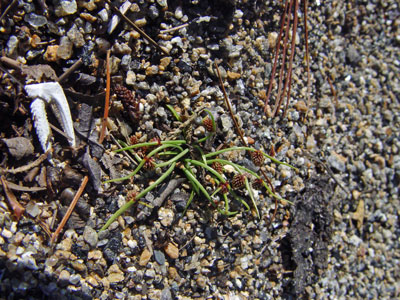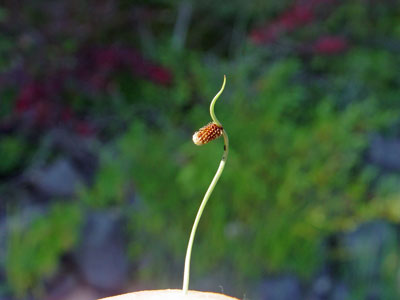DACF Home → Bureaus & Programs → Maine Natural Areas Program → Communities, Plants, and Animals → Rare Plants → Lipocarpha micrantha

Lipocarpha micrantha (Vahl) G. Tucker
Dwarf Bulrush
- State Rank: S1
- Global Rank: G5
- State Status: Threatened
Habitat: Sandy borders of ponds and streams. [Open wetland, not coastal nor rivershore (non-forested, wetland)]
Range: Maine to Ontario, Washington, Florida, Texas, Mexico and South America.
Aids to Identification: Dwarf bulrush resembles the closely related bull-rushes (Schoenoplectus spp.), but as indicated by its name, is dwarfed, reaching 15 cm high at most, with drooping, narrow leaves. The spikes, 2-3 per stem, are 2-6 mm long, oval, covered with brown scales, and appear to emerge from the side of the stem because one of the bracts is erect and resembles a continuation of the stem. Also superficially similar is the sedge Fimbrisylis autumnalis, which has small (3-7 mm long), egg-shaped fruiting heads (spikes) but lacks the leaf-like bract of dwarf bulrush.

Ecological characteristics: Ecological relationships in Maine are not well known.
Phenology: Flowers and fruits in late summer (July - September).
Family: Cyperaceae
Synonyms: Hemicarpha micrantha (Vahl) Pax; Scirpus micranthus Vahl.
Known Distribution in Maine: This rare plant has historically been documented from a total of 7 town(s) in the following county(ies): Androscoggin, Kennebec, Oxford, Sagadahoc, York.
Reason(s) for rarity: At northeastern limit of its range.
Conservation considerations: Heavy recreational use of the sandy habitats where this occurs has degraded the habitat in some locations and continued use will be detrimental to the plant populations.